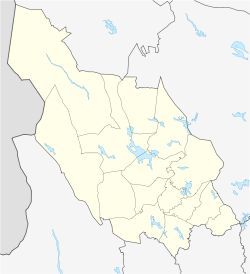Hedemora
| Hedemora | |
|---|---|
|
September 2007 aerial view of Hedemora | |
 Hedemora  Hedemora | |
| Coordinates: 60°16′37″N 15°59′14″E / 60.27694°N 15.98722°ECoordinates: 60°16′37″N 15°59′14″E / 60.27694°N 15.98722°E | |
| Country | Sweden |
| Province | Dalarna |
| County | Dalarna County |
| Municipality | Hedemora Municipality |
| Area[1] | |
| • Total | 6.12 km2 (2.36 sq mi) |
| Population (31 December 2010)[1] | |
| • Total | 7,273 |
| • Density | 1,189/km2 (3,080/sq mi) |
| Time zone | CET (UTC+1) |
| • Summer (DST) | CEST (UTC+2) |
Hedemora is a locality in Dalarna County and the seat of Hedemora Municipality, Sweden, with 7,273 inhabitants in 2010.[1]
Despite its small population, Hedemora is for historical reasons normally still referred to as a city, and as such the oldest in the county. Statistics Sweden, however, only counts localities with more than 10,000 inhabitants as cities.
Jonas Nilsson comes from Hedemora, as well as Kerstin Thorborg, Martin Matsbo, Bertil Norman and Ulf Stenlund. The diesel engines from Hedemora Diesel can be found in many ships built by Kockums, such as HMS Orion, the Collins class submarines in the Royal Australian Navy Submarine Service and the Archer class submarines in the Republic of Singapore Navy.
History

The town Hedemora was chartered in 1446, which means it is the oldest and only medieval town in Dalarna.
In 1754 and 1849 the town was severely hit by fire. The fire in 1754 destroyed 90 out of the 110 house lots in the town, including all the grain storages. However, the massive destruction made it possible to modernize the town structure, with straighter blocks and streets.
Hedemora held Gustav I of Sweden's first mint, in use 1521–1524.
See also
References
| Wikimedia Commons has media related to Hedemora. |
- 1 2 3 "Tätorternas landareal, folkmängd och invånare per km2 2005 och 2010" (in Swedish). Statistics Sweden. 14 December 2011. Archived from the original on 10 January 2012. Retrieved 10 January 2012.